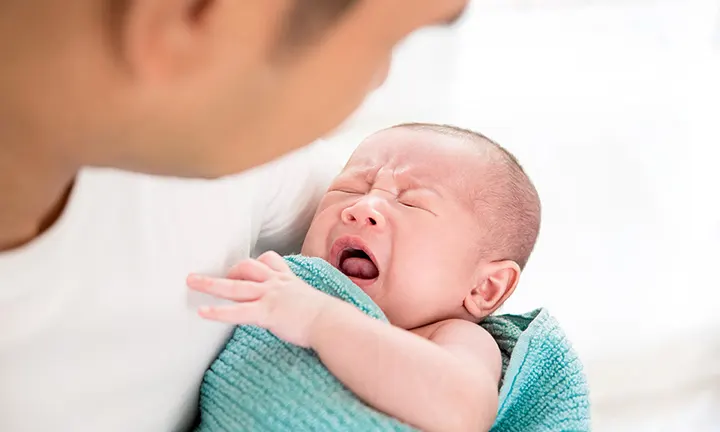HFMD: Hand, Foot, and Mouth Disease
Hand, foot, and mouth disease (HFMD) is a contagious viral infection that most often affects young children and causes painful blisters. If your little one is diagnosed with HFMD, there are steps you can take to help ensure a more comfortable recovery. With the right care, your child will be right back to normal within a few days.
Read on to learn more about the symptoms of HFMD, its causes, and what treatment is available.
What Is HFMD (Hand, Foot, and Mouth Disease)?
Hand, foot, and mouth disease is an infection caused by a virus, most commonly by the Coxsackie virus. It causes painful red blisters on the hands, feet, mouth, throat, and diaper area.
HFMD is typically a minor childhood illness causing just a few days of fever and usually minor symptoms.
Outbreaks of HFMD occur more often in the spring, summer, and fall in North America. The illness is more likely to affect children under 5 years old, although the virus can infect children up to 10 years old. Likewise, although it’s unusual, it can also infect adolescents and adults.
Hand, Foot, and Mouth Disease Symptoms
The first sign of HFMD infection is often a fever, followed by a sore throat and loss of appetite. It usually takes about three to six days after your child is first infected for these symptoms to start showing.
About a day or two after your little one comes down with the initial fever, painful sores begin to develop in the throat or in the front of the mouth. A rash on the hands and feet or diaper area might follow within a day or two after that.
Just to recap, here are the most common symptoms of HFMD. Keep in mind that your little one might have all or only a few of them:
Fever
Sore throat
Poor appetite
General irritability and tiredness
Painful red blisters on the tongue or inside of the mouth
A red rash that doesn’t itch but sometimes blisters on the palms of the hands, soles of the feet, or the diaper area.
How Does HFMD Spread?
Your little one is most likely to catch hand, foot, and mouth disease if he comes into contact with an infected person’s
nasal or throat secretions (for example, from sneezing or coughing)
spit
stool
fluid from HFMD blisters.
The illness can spread easily in child care settings because of all the diaper changes and, potty training going on, and because your little one might still be prone to putting his hands in his mouth.
When to Contact Your Child’s Healthcare Provider
If you notice sores in your child’s mouth or if a sore throat prevents him from drinking, contact his healthcare provider. Let your child’s provider know if your little one’s symptoms get worse after a few days, too.
Your child’s healthcare provider will consider these things when diagnosing HFMD:
Your little one’s age
The pattern of the symptoms
Whether the rash or sores look like those caused by HFMD
In some cases, the lab results from a stool sample or throat swab.
What Is the Treatment for Hand, Foot, and Mouth Disease?
Treatment can be given to help ease the discomfort of the symptoms for your little one. For example, your child’s healthcare provider may recommend an over-the-counter pain and fever reducer.
Always check with your child’s healthcare provider about care and treatment, especially for infants and young babies. These are some possible at-home remedies for HFMD that might help comfort and help a toddler or older child:
Give her ice cream, ice pops, or ice chips
Let her sip on ice water or cold milk
Avoid giving her spicy or salty foods
Feed her soft foods that are low in acid such as egg whites, avocado, or applesauce
Rinse your little one’s mouth with warm water after she eats
Ensure she drinks plenty of water to help prevent dehydration.
Potential HFMD Complications
Although HFMD is usually a minor illness, it can sometimes worsen and cause more serious complications. Usually, dehydration is the first complication, as the sores in your little one’s mouth or throat can make swallowing painful. Make sure your child sips fluid frequently throughout the day while she’s ill. If dehydration gets severe, your child’s healthcare provider may recommend she be given fluids intravenously (IV).
It is rare, but sometimes a serious form of the HFMD virus can cause these two complications:
Encephalitis. This is a rare, but life-threatening inflammation of the brain.
Viral meningitis. This causes inflammation of the membranes and fluids surrounding the spinal cord and brain.
If your child is diagnosed with HFMD, your healthcare provider can let you know what signs or symptoms to watch out for to help prevent HFMD from worsening.
Hand, Foot, and Mouth Disease Prevention
As your little one gets older, she may develop immunity to HFMD by building antibodies against it if she was previously exposed to the virus.
In any case, here are some precautions you can take to help prevent your little one from getting the infection:
Try to prevent close contact with others who have HFDM
Keep your and your little one’s hands clean with frequent washes, especially after changing diapers
Disinfect surfaces and objects that may have been touched or used by someone who has HFDM, such as doorknobs, toilet and water faucet handles, and toys, for example.
How to Help Prevent the Spread of HFMD
Try to keep your little one away from others as much as possible if she has HFMD. At home, this can be harder, but urge all family members to avoiding touching their eyes, nose, and mouth. Insist on frequent handwashing for everyone, and disinfect high-traffic surfaces regularly.
Your little one is most contagious in the first week, but the virus can remain in her body weeks after the symptoms have disappeared. As long as the virus is in the body, it can infect others. If possible, keep your little one out of child care or school if she has a fever or any HFMD blisters.
Keeping your infected little one out of child care or school for more than a week may not be an option for you. If that’s the case, let the child care center or school know so they can take extra precautions such as extra hand washing and disinfecting to help prevent HFMD from spreading to the other children.
FAQS AT A GLANCE
Fever is usually the first symptom of HFMD followed by a sore throat and possibly blisters in the mouth.
The Bottom Line
Hand, foot, and mouth disease is a common infection, and it often goes away within a few days. If your little one catches it, just try to keep her as comfortable as possible and trust your child’s healthcare provider to offer some good suggestions to ease the symptoms. Things will return to normal soon enough.
Keeping your little one’s bottom dry and clean is important. We can help with that! Turn all those Pampers diapers and wipes into rewards and coupons by downloading the Pampers Club app today.
Join Pampers Club and get:




